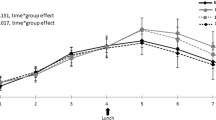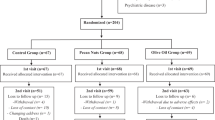Abstract
Background/Objectives:
Although benefits have been attributed to the Mediterranean diet, its effect on glycaemic control has not been totally elucidated. The aim of this work was to compare the effect of two Mediterranean diets versus a low-fat diet on several parameters and indices related to glycaemic control in type 2 diabetic subjects.
Subjects/Methods:
A multicentric parallel trial was conducted on 191 participants (77 men and 114 women) of the PREDIMED study in order to compare three dietary interventions: two Mediterranean diets supplemented with virgin olive oil (n=67; body mass index (BMI)=29.4±2.9) or mixed nuts (n=74; BMI=30.1±3.1) and a low-fat diet (n=50; BMI=29.8±2.8). There were no drop-outs. Changes in body weight and waist circumference were determined. Insulin resistance was measured by HOMA-IR index, adiponectin/leptin and adiponectin/HOMA-R ratios after 1 year of follow-up.
Results:
Increased values of adiponectin/leptin ratio (P=0.043, P=0.001 and P<0.001 for low-fat, olive oil and nut diets, respectively) and adiponectin/HOMA-IR ratio (P=0.061, P=0.027 and P=0.069 for low-fat, olive oil and nut diets, respectively) and decreased values of waist circumference (P=0.003, P=0.001 and P=0.001 for low-fat, olive oil and nut diets, respectively) were observed in the three groups. In both Mediterranean diet groups, but not in the low-fat diet group, this was associated with a significant reduction in body weight (P=0.347, P=0.003 and P=0.021 for low-fat, olive oil and nut diets, respectively).
Conclusions:
Mediterranean diets supplemented with virgin olive oil or nuts reduced total body weight and improved glucose metabolism to the same extent as the usually recommended low-fat diet.
This is a preview of subscription content, access via your institution
Access options
Subscribe to this journal
Receive 12 print issues and online access
$259.00 per year
only $21.58 per issue
Buy this article
- Purchase on Springer Link
- Instant access to full article PDF
Prices may be subject to local taxes which are calculated during checkout
Similar content being viewed by others
References
Keys A, Menotti A, Karvonen MJ, Aravanis C, Blackburn H, Buzina R et al. The diet and 15-year death rate in the seven countries study. Am J Epidemiol 1986; 124: 903–915.
Sofi F, Abbate R, Gensini GF, Casini A . Accruing evidence on benefits of adherence to the Mediterranean diet on health: an updated systematic review and meta-analysis. Am J Clin Nutr 2010; 92: 1189–1196.
Buckland G, González CA, Agudo A, Vilardell M, Berenguer A, Amiano P et al. Adherence to the Mediterranean diet and risk of coronary heart disease in the Spanish EPIC cohort study. Am J Epidemiol 2009; 170: 1518–1529.
Trichopoulou A, Bamia C, Norat T, Overvad K, Schmidt EB, Tjønneland A et al. Modified Mediterranean diet and survival after myocardial infarction: the EPIC-Elderly study. Eur J Epidemiol 2007; 22: 871–881.
Sofi F, Abbate R, Gensini GF, Casini A . Which diet for an effective cardiovascular prevention? Monaldi Arch Chest Dis 2012; 78: 60–65.
Klonizakis M, Alkhatib A, Middleton G, Smith MF . Mediterranean diet- and exercise-induced improvement in age-dependent vascular activity. Clin Sci (Lond) 2013; 124: 579–587.
Richard C, Couture P, Desroches S, Benjannet S, Seidah NG, Lichtenstein AH et al. Effect of the Mediterranean diet with and without weight loss on surrogate markers of cholesterol homeostasis in men with the metabolic syndrome. Br J Nutr 2012; 107: 705–711.
Panagiotakos DB, Polystipioti A, Papairakleous N, Polychronopoulos E . Long-term adoption of a Mediterranean diet is associated with a better health status in elderly people; a cross-sectional survey in Cyprus. Asia Pac J Clin Nutr 2007; 16: 331–337.
Kastorini CM, Panagiotakos DB . Mediterranean diet and diabetes prevention: Myth or fact? World J Diabetes 2010; 1: 65–67.
Salas-Salvadó J, Bulló M, Babio N, Martínez-González M, Ibarrola-Jurado N, Basora J et al. Reduction in the incidence of type 2 diabetes with the Mediterranean diet: results of the PREDIMED-Reus nutrition intervention randomized trial. Diabetes Care 2011; 34: 14–19.
Esposito K, Maiorino MI, Ceriello A, Giugliano D . Prevention and control of type 2 diabetes by Mediterranean diet: a systematic review. Diabetes Res Clin Pract 2010; 89: 97–102.
Romaguera D, Guevara M, Norat T, Langenberg C, Forouhi NG, Sharp S et al. Mediterranean diet and type 2 diabetes risk in the European Prospective Investigation into Cancer and Nutrition (EPIC) study: the InterAct project. Diabetes Care 2011; 34: 1913–1918.
Panagiotakos DB, Tzima N, Pitsavos C, Chrysohoou C, Papakonstantinou E, Zampelas A et al. The relationship between dietary habits, blood glucose and insulin levels among people without cardiovascular disease and type 2 diabetes; the ATTICA study. Rev Diabet Stud 2005; 2: 208–215.
Singh RB, Dubnov G, Niaz MA, Ghosh S, Singh R, Rastogi SS et al. Effect of an Indo-Mediterranean diet on progression of coronary artery disease in high risk patients (Indo-Mediterranean Diet Heart Study): a randomised single-blind trial. Lancet 2002; 360: 1455–1461.
Ciccarone E, Di Castelnuovo A, Assanelli D, Archetti S, Ruggeri G, Salcuni N et al. Homocysteine levels are associated with the severity of peripheral arterial disease in Type 2 diabetic patients. J Thromb Haemost 2003; 1: 2540–2547.
Estruch R, Ros E, Salas-Salvadó J, Covas MI, Corella D, Arós F et al. Primary prevention of cardiovascular disease with a Mediterranean diet. N Engl J Med 2013; 368: 1279–1290.
Association AD. Diagnosis and classification of diabetes mellitus. Diabetes Care 2008; 31: S55–S60.
Nigg CR, Burbank PM, Padula C, Dufresne R, Rossi JS, Velicer WF et al. Stages of change across ten health risk behaviors for older adults. Gerontologist 1999; 39: 473–482.
Fernández-Ballart JD, Piñol JL, Zazpe I, Corella D, Carrasco P, Toledo E et al. Relative validity of a semi-quantitative food-frequency questionnaire in an elderly Mediterranean population of Spain. Br J Nutr 2010; 103: 1808–1816.
Elosua R, Garcia M, Aguilar A, Molina L, Covas MI, Marrugat J . Validation of the Minnesota Leisure Time Physical Activity Questionnaire In Spanish Women. Investigators of the MARATDON Group. Med Sci Sports Exerc 2000; 32: 1431–1437.
Matthews DR, Hosker JP, Rudenski AS, Naylor BA, Treacher DF, Turner RC . Homeostasis model assessment: insulin resistance and beta-cell function from fasting plasma glucose and insulin concentrations in man. Diabetologia 1985; 28: 412–419.
Zaletel J, Barlovic DP, Prezelj J . Adiponectin-leptin ratio: a useful estimate of insulin resistance in patients with Type 2 diabetes. J Endocrinol Invest 2010; 33: 514–518.
Wallace TM, Levy JC, Matthews DR . Use and abuse of HOMA modeling. Diabetes Care 2004; 27: 1487–1495.
Oda N, Imamura S, Fujita T, Uchida Y, Inagaki K, Kakizawa H et al. The ratio of leptin to adiponectin can be used as an index of insulin resistance. Metabolism 2008; 57: 268–273.
Galic S, Oakhill JS, Steinberg GR . Adipose tissue as an endocrine organ. Mol Cell Endocrinol 2010; 316: 129–139.
Koh SB, Park JK, Yoon JH, Chang SJ, Oh SS, Kim JY et al. Preliminary report: a serious link between adiponectin levels and metabolic syndrome in a Korean nondiabetic population. Metabolism 2010; 59: 333–337.
Nakashima R, Yamane K, Kamei N, Nakanishi S, Kohno N . Low serum levels of total and high-molecular-weight adiponectin predict the development of metabolic syndrome in Japanese-Americans. J Endocrinol Invest 2011; 34: 615–619.
Kajikawa Y, Ikeda M, Takemoto S, Tomoda J, Ohmaru N, Kusachi S . Association of circulating levels of leptin and adiponectin with metabolic syndrome and coronary heart disease in patients with various coronary risk factors. Int Heart J 2011; 52: 17–22.
Yun JE, Kimm H, Jo J, Jee SH . Serum leptin is associated with metabolic syndrome in obese and nonobese Korean populations. Metabolism 2010; 59: 424–429.
Yoon JH, Park JK, Oh SS, Lee KH, Kim SK, Cho IJ et al. The ratio of serum leptin to adiponectin provides adjunctive information to the risk of metabolic syndrome beyond the homeostasis model assessment insulin resistance: the Korean Genomic Rural Cohort Study. Clin Chim Acta 2011; 412: 2199–2205.
Inoue M, Yano M, Yamakado M, Maehata E, Suzuki S . Relationship between the adiponectin-leptin ratio and parameters of insulin resistance in subjects without hyperglycemia. Metabolism 2006; 55: 1248–1254.
Satoh N, Naruse M, Usui T, Tagami T, Suganami T, Yamada K et al. Leptin-to-adiponectin ratio as a potential atherogenic index in obese type 2 diabetic patients. Diabetes Care 2004; 27: 2488–2490.
Kotani K, Sakane N, Saiga K, Kurozawa Y . Leptin: adiponectin ratio as an atherosclerotic index in patients with type 2 diabetes: relationship of the index to carotid intima-media thickness. Diabetologia 2005; 48: 2684–2686.
Nakatochi M, Miyata S, Tanimura D, Izawa H, Asano H, Murase Y et al. The ratio of adiponectin to homeostasis model assessment of insulin resistance is a powerful index of each component of metabolic syndrome in an aged Japanese population: results from the KING Study. Diabetes Res Clin Pract 2011; 92: e61–e65.
de Luis DA, Aller R, Izaola O, Conde R, Gonzalez Sagrado M . The ratio of adiponectin to HOMA as an index of metabolic syndrome in obese women. Ann Nutr Metab 2011; 58: 301–306.
Babio N, Bulló M, Salas-Salvadó J . Mediterranean diet and metabolic syndrome: the evidence. Public Health Nutr 2009; 12: 1607–1617.
Rodríguez VM, Portillo MP, Picó C, Macarulla MT, Palou A . Olive oil feeding up-regulates uncoupling protein genes in rat brown adipose tissue and skeletal muscle. Am J Clin Nutr 2002; 75: 213–220.
Kien CL, Bunn JY, Ugrasbul F . Increasing dietary palmitic acid decreases fat oxidation and daily energy expenditure. Am J Clin Nutr 2005; 82: 320–326.
Soares MJ, Cummings SJ, Mamo JC, Kenrick M, Piers LS . The acute effects of olive oil v. cream on postprandial thermogenesis and substrate oxidation in postmenopausal women. Br J Nutr 2004; 91: 245–252.
Salas-Salvadó J, Martinez-González M, Bulló M, Ros E . The role of diet in the prevention of type 2 diabetes. Nutr Metab Cardiovasc Dis 2011; 21: B32–B48.
Miljkovic-Gacic I, Wang X, Kammerer CM, Bunker CH, Wheeler VW, Patrick AL et al. Genetic determination of adiponectin and its relationship with body fat topography in multigenerational families of African heritage. Metabolism 2007; 56: 234–238.
Nakamura Y, Sekikawa A, Kadowaki T, Kadota A, Kadowaki S, Maegawa H et al. Visceral and subcutaneous adiposity and adiponectin in middle-aged Japanese men: the ERA JUMP study. Obesity (Silver Spring) 2009; 17: 1269–1273.
Milewicz A, Jedrzejuk D, Dunajska K, Lwow F . Waist circumference and serum adiponectin levels in obese and non-obese postmenopausal women. Maturitas 2010; 65: 272–275.
Manabe Y MS, Fushiki T . Preference for high-fat food in animals. In: Montmayeur JP, Le Coutre J, (eds). Fat Detection: Taste, Texture, and Post Ingestive Effects. CRC Press: Boca Raton, FL, USA, 2010, chapter 10.
Acknowledgements
This study was funded by the Spanish Ministry of Health (PI1001407, AGL2009-130906-C02-02, AGL2010-22319-C03-02, G03/140, RD06/0045), by Carlos III Health Institute (PREDIMED; CIBERobn), by Public Health Division of the Department of Health of the Autonomous Government of Catalonia in collaboration with Merck Sharp & Dohme Laboratories, by the Government of the Basque Country (IT-572-13) and by the University of the Basque Country (EDUNANOTEK, UFI11/32).
Author information
Authors and Affiliations
Corresponding author
Ethics declarations
Competing interests
The authors declare no conflict of interest.
Rights and permissions
About this article
Cite this article
Lasa, A., Miranda, J., Bulló, M. et al. Comparative effect of two Mediterranean diets versus a low-fat diet on glycaemic control in individuals with type 2 diabetes. Eur J Clin Nutr 68, 767–772 (2014). https://doi.org/10.1038/ejcn.2014.1
Received:
Revised:
Accepted:
Published:
Issue Date:
DOI: https://doi.org/10.1038/ejcn.2014.1
Keywords
This article is cited by
-
The gut microbiome as mediator between diet and its impact on immune function
Scientific Reports (2022)
-
Improving type 2 diabetes mellitus glycaemic control through lifestyle modification implementing diet intervention: a systematic review and meta-analysis
European Journal of Nutrition (2020)
-
Differential effects of a combination of Hibiscus sabdariffa and Lippia citriodora polyphenols in overweight/obese subjects: A randomized controlled trial
Scientific Reports (2019)
-
A network meta-analysis on the comparative efficacy of different dietary approaches on glycaemic control in patients with type 2 diabetes mellitus
European Journal of Epidemiology (2018)
-
Low glycemic index diet, exercise and vitamin D to reduce breast cancer recurrence (DEDiCa): design of a clinical trial
BMC Cancer (2017)



